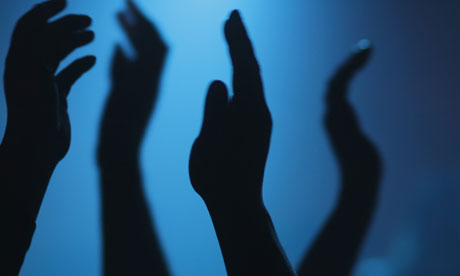So this is a matter that I often find very disturbing as a musician. This is somewhat a guide to how to clap your hands at a concert. This is mostly useless I guess as musicians already know this and if you're not a musician you're not reading this but anyway.
I love clapping my hands at concerts or snapping my fingers. It's a bit like "soft-dancing" when you're at a sitted concert.
When I'm playing a concert I'm not so hot on people clapping their hands. Of course, it's really nice and it means the people really are into the music you're playing (unless you're subbing in the local concert band with 10 people eating pies and they're clapping like yeah yeah because the conductor is all hot on making the audience clap their hands). But it can get really disturbing because as a musician you have to learn not to listen to the audience clap because they're not musicians and they don't know what a tempo is or how to keep it. So there are many chances you'll get faster or slower with the audience (usually faster unless we're in the situations described above where the audience just came to eat the pies and you're disturbing them more than entertaining them). And that's a first problem.
A funny thing is, I once played "Music" from John Miles. The middle bit is a 7/4. The audience was clapping every other beat. Imagine how weird it was !!
But anyway, when you're in the audience, this shouldn't bother you too much, you're at the concert to enjoy yourself and if you want to clap you hands, just go for it, even if you're the only one clapping, people will eventually join you (maybe). Plus, the musicians are always happy.
BUT !!
And see, that was a big but (hum).
Don't clap on 1 and 3 !!!
Please please please please please.
Of course, clapping on 1 and 3 is what feels natural, at first at least. Because those are the strong beats, but clapping on them lacks so much energy.
"But, what does clapping on 1 and 3 mean ?"
If you don't what "clapping on 1 and 3" means then that's probably what you're doing. If you know what that means, and you do it, stop doing it and clap on 2 and 4 !!
Beats 2 and 4 are the upbeats, they are usually called the weak beats. That's because when you're playing a classical piece you're accentuating the downbeats (1 and 3). But when jazz arrived, the upbeats grew more and more important and the upbeats are stronger in that style. And since most of the modern music (pop, rock and all that) derives one way or another from jazz, this applies as well to those styles.
So that's why it's always better to clap on 2 and 4. If you don't know what that means, concentrate on how you would naturally clap and clap between the claps you would usually clap and you will be clapping on 2 and 4.
If you didn't get that, let's make a bit of music theory : a piece of music is divided in measures that are themselves, most of the time in modern music, divided in 4 beats :
1 2 3 4
Here's what you're certainly doing :
1 2 3 4
Clap Clap
Here's what you should be doing :
1 2 3 4
Clap Clap
Hope it makes it easier for you.
If you still don't get it, ask a musician friend of yours and he will most probably be delighted to explain all of this to you.
In the mean time, I salute you. So go to concerts, listen to music (all styles), and clap on 2 and 4 ;)

No comments:
Post a Comment